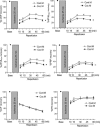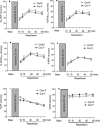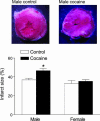Prenatal cocaine exposure increases heart susceptibility to ischaemia-reperfusion injury in adult male but not female rats
- PMID: 15677681
- PMCID: PMC1464496
- DOI: 10.1113/jphysiol.2005.082701
Prenatal cocaine exposure increases heart susceptibility to ischaemia-reperfusion injury in adult male but not female rats
Abstract
The present study tested the hypothesis that prenatal cocaine exposure differentially regulates heart susceptibility to ischaemia-reperfusion (I/R) injury in adult offspring male and female rats. Pregnant rats were administered intraperitoneally either saline or cocaine (15 mg kg(-1)) twice daily from day 15 to day 21 of gestational age. There were no differences in maternal weight gain and birth weight between the two groups. Hearts were isolated from 2-month-old male and female offspring and were subjected to I/R (25 min/60 min) in a Langendorff preparation. Preischaemic values of left ventricular (LV) function were the same between the saline control and cocaine-treated hearts for both male and female rats. Prenatal cocaine exposure significantly increased I/R-induced myocardial apoptosis and infarct size, and significantly attenuated the postischaemic recovery of LV function in adult male offspring. In contrast, cocaine did not affect I/R-induced injury and postischaemic recovery of LV function in the female hearts. There was a significant decrease in PKCepsilon and phospho-PKCepsilon levels in LV in the male, but not female, offspring exposed to cocaine before birth. These results suggest that prenatal cocaine exposure causes a sex-specific increase in heart susceptibility to I/R injury in adult male offspring, and the decreased PKCepsilon gene expression in the male heart may play an important role.
Figures







Similar articles
-
Prenatal nicotine exposure increases heart susceptibility to ischemia/reperfusion injury in adult offspring.J Pharmacol Exp Ther. 2008 Jan;324(1):331-41. doi: 10.1124/jpet.107.132175. Epub 2007 Oct 18. J Pharmacol Exp Ther. 2008. PMID: 17947495 Free PMC article.
-
Short- and long-term adverse effects of cocaine abuse during pregnancy on the heart development.Ther Adv Cardiovasc Dis. 2009 Feb;3(1):7-16. doi: 10.1177/1753944708099877. Ther Adv Cardiovasc Dis. 2009. PMID: 19144667 Free PMC article. Review.
-
Prenatal cocaine exposure increases apoptosis of neonatal rat heart and heart susceptibility to ischemia-reperfusion injury in 1-month-old rat.Br J Pharmacol. 2005 Apr;144(7):900-7. doi: 10.1038/sj.bjp.0706129. Br J Pharmacol. 2005. PMID: 15685203 Free PMC article.
-
Prenatal cocaine exposure abolished ischemic preconditioning-induced protection in adult male rat hearts: role of PKCepsilon.Am J Physiol Heart Circ Physiol. 2009 May;296(5):H1566-76. doi: 10.1152/ajpheart.00898.2008. Epub 2009 Mar 13. Am J Physiol Heart Circ Physiol. 2009. PMID: 19286950 Free PMC article.
-
Postnatal consequences of prenatal cocaine exposure and myocardial apoptosis: does cocaine in utero imperil the adult heart?Br J Pharmacol. 2005 Apr;144(7):887-8. doi: 10.1038/sj.bjp.0706130. Br J Pharmacol. 2005. PMID: 15685202 Free PMC article. Review.
Cited by
-
Does Prenatal Exposure to CNS Stimulants Increase the Risk of Cardiovascular Disease in Adult Offspring?Front Cardiovasc Med. 2021 Mar 4;8:652634. doi: 10.3389/fcvm.2021.652634. eCollection 2021. Front Cardiovasc Med. 2021. PMID: 33748200 Free PMC article. Review.
-
Prenatal nicotine exposure increases heart susceptibility to ischemia/reperfusion injury in adult offspring.J Pharmacol Exp Ther. 2008 Jan;324(1):331-41. doi: 10.1124/jpet.107.132175. Epub 2007 Oct 18. J Pharmacol Exp Ther. 2008. PMID: 17947495 Free PMC article.
-
Short- and long-term adverse effects of cocaine abuse during pregnancy on the heart development.Ther Adv Cardiovasc Dis. 2009 Feb;3(1):7-16. doi: 10.1177/1753944708099877. Ther Adv Cardiovasc Dis. 2009. PMID: 19144667 Free PMC article. Review.
-
Neonatal Lipopolysaccharide Exposure Gender-Dependently Increases Heart Susceptibility to Ischemia/Reperfusion Injury in Male Rats.Int J Med Sci. 2017 Sep 19;14(11):1163-1172. doi: 10.7150/ijms.20285. eCollection 2017. Int J Med Sci. 2017. PMID: 29104471 Free PMC article.
-
Prenatal cocaine exposure causes sex-dependent impairment in the myogenic reactivity of coronary arteries in adult offspring.Hypertension. 2009 Nov;54(5):1123-8. doi: 10.1161/HYPERTENSIONAHA.109.138024. Epub 2009 Aug 24. Hypertension. 2009. PMID: 19704103 Free PMC article.
References
-
- Bae S, Xiao Y, Li G, Casiano CA, Zhang L. Effect of maternal chronic hypoxic exposure during gestation on apoptosis in fetal rat heart. Am J Physiol Heart Circ Physiol. 2003;285:H983–H990. - PubMed
-
- Barker DJ. In utero programming of cardiovascular disease. Theriogenology. 2000;5:555–574. - PubMed
-
- Bogoyevitch MA, Parker PJ, Sugden PH. Characterization of protein kinase C isotype expression in adult rat heart. Protein kinase C-epsilon is a major isotype present, and it is activated by phorbol esters, epinephrine, and endothelin. Circ Res. 1993;72:757–767. - PubMed
-
- Camper-Kirby D, Welch S, Walker A, Shiraishi I, Setchell KDR, Schaefer E, Kajstura J, Anversa P, Sussman MA. Myocardial Akt activation and gender: increased nuclear activity in females versus males. Circ Res. 2001;88:1020–1027. - PubMed
Publication types
MeSH terms
Substances
Grants and funding
LinkOut - more resources
Full Text Sources
Medical

